 |
Hi everyone — Dan here. Today’s post is written by my friend Brian Tobal. He has one of the most unique and interesting reading processes I’ve ever encountered, so I invited him on to Superorganizers to share it with us. I’ve picked up a lot from learning how he reads, and I hope you do too. Here’s Brian…
It’s always a little awkward when people ask what I’m reading, because usually it’s about a dozen books at once.
But I’m not reading this way for show — I’m doing it because I think reading this way is actually better. At least for me.
It’s a process I’ve developed called surgical reading and it means that when I’m reading a non-fiction book, I focus on locating and removing the most valuable pieces of information from it quickly as possible. This allows me to read many different books across a single topic at once, so I can look at it from multiple perspectives. My goal is to quickly locate valuable knowledge and use the information I acquire in the real world to solve problems.
There are a lot of hidden benefits to this approach. First, I can quickly get a sense of how interested I am in a book, and hence I spend more time reading things I’m actually interested in. When I’m not interested in a book I can drop it and move on to something else, knowing that if I return it will be for a reason. Reading shouldn’t be about checking titles off of a todo list, it should be an exploration of what fascinates you.
Second, I can view a topic from multiple perspectives and really understand the issues. Rather than rely on the account of one author, I can see how many different people talk about the same events, and ideas. This gives me a much more nuanced perspective on whatever topic I’m currently interested in.
Finally, it transforms books into something more active and less passive. My library has gone from a storage space to something that’s alive, something that I’m constantly interacting with.
And, of course, when I find a book I really like, which happens more often now, I can get the most out of it.
Who I Am
My name is Brian Tobal, and I spend most of my time thinking about learning. Over the past 15 years, I’ve worn a lot of hats in the education world. I’ve been an elementary school science teacher, a researcher at an educational research firm, head of product at a half-dozen ed-tech startups, and also a founder of a few startups myself including a company called Hickory that I sold in 2018.
I love startups. From a learning perspective, they allow you to fully immerse into new fields and, by their nature, force you to solve real problems. This has informed my own personal approach to learning and therefore to reading. I don’t build a knowledge base just to have knowledge. I build it to use it. Typically as soon as I can.
That’s what surgical reading is designed to help me do.
So are you ready to give it a try? Go pull some book off the shelf that’s been sitting there for a while, hopefully one that you haven’t read. Follow along with me, and see for yourself what it’s like to read surgically.
Let’s get started!
Use the Book Itself as a Map
Here’s a breakdown of how I go about reading a book:
Approach a book
Judge a book by its cover
The index is everything
Use the TOC as the skeleton
Preview with the preface
The point of this process is to gain the ability to “map out” any book in ~ 15 minutes. You want to walk away with a sense of where the valuable knowledge is located, what interests you, and how much time you want to devote to reading it.
Below, we’ll do a walkthrough of the process of extracting the important points (knowledge nuggets, if you will) from one book, how to compound the value of reading a single book at a time, and how to combine everything so that you can easily ingest multiple books at once.
Approaching a Book
Before I start reading a non-fiction book, I’ll take between 5-10 minutes and try to get a sense of what value it has to me and how it is structured. We all do this in some fashion when deciding that we want to read a book. Maybe you read some reviews or quotes on Amazon, or leaf through some random sections. I prefer to use the book itself.
Again, I’m typically not interested in reading the book start to finish, and so if I’m going to remove the information I need, I need to locate it first. What I want is a map (either mentally or written out) of what the book is about. You can use your built in brain memory, a notecard, a Google Doc, or some fancy-pants note-taking system as the capture mechanism—you make you happy here.
Judge a Book by its Cover
I start by giving the title and subtitle some thought. I know it sounds mundane, but authors spend a lot of time thinking of these, and typically they signal a point of view.
For instance, take A Short History of the United States versus A People’s History of the United States. What does the author mean to imply by emphasizing “People” instead of “Short”? Or The American President versus Accidental Presidents. Again, “Accidental” stands out here and implies a point of view, while alluding to the content behind the cover.
One of my favorite titles isWeb Form Design, subtitled Filling in the Gaps. The whole book is about designing web forms, and that punny sense of humor is infused throughout.
The Index is Everything
You can take any path you want, but for me, the index is my first stop after the title. Armed with a guess of the book's point of view from the title, I use the index to understand what topics we’re going to cover and hopefully how we’re going to approach them.
If you want to play along, open that non-fiction book you haven’t read yet — or just see the example below.
Look through the index, notice what topics are covered, and more importantly, at what depth. If an author is spending a good deal of pages on something, make a note of that topic. (You might try Dan’s fourfold index approach for this!)
Remember, what we’re trying to do with this process is answer two questions: what is this book about, and, am I interested in reading it? I’ll take a look at a random book from my bookshelf and look through the index, right now. Turns out this book is Homo Deus by Yuval Noah Harari.
Ok, first index page...boom! What do I see?
What stands out? What topics get a lot of coverage? What seems interesting or out of place?
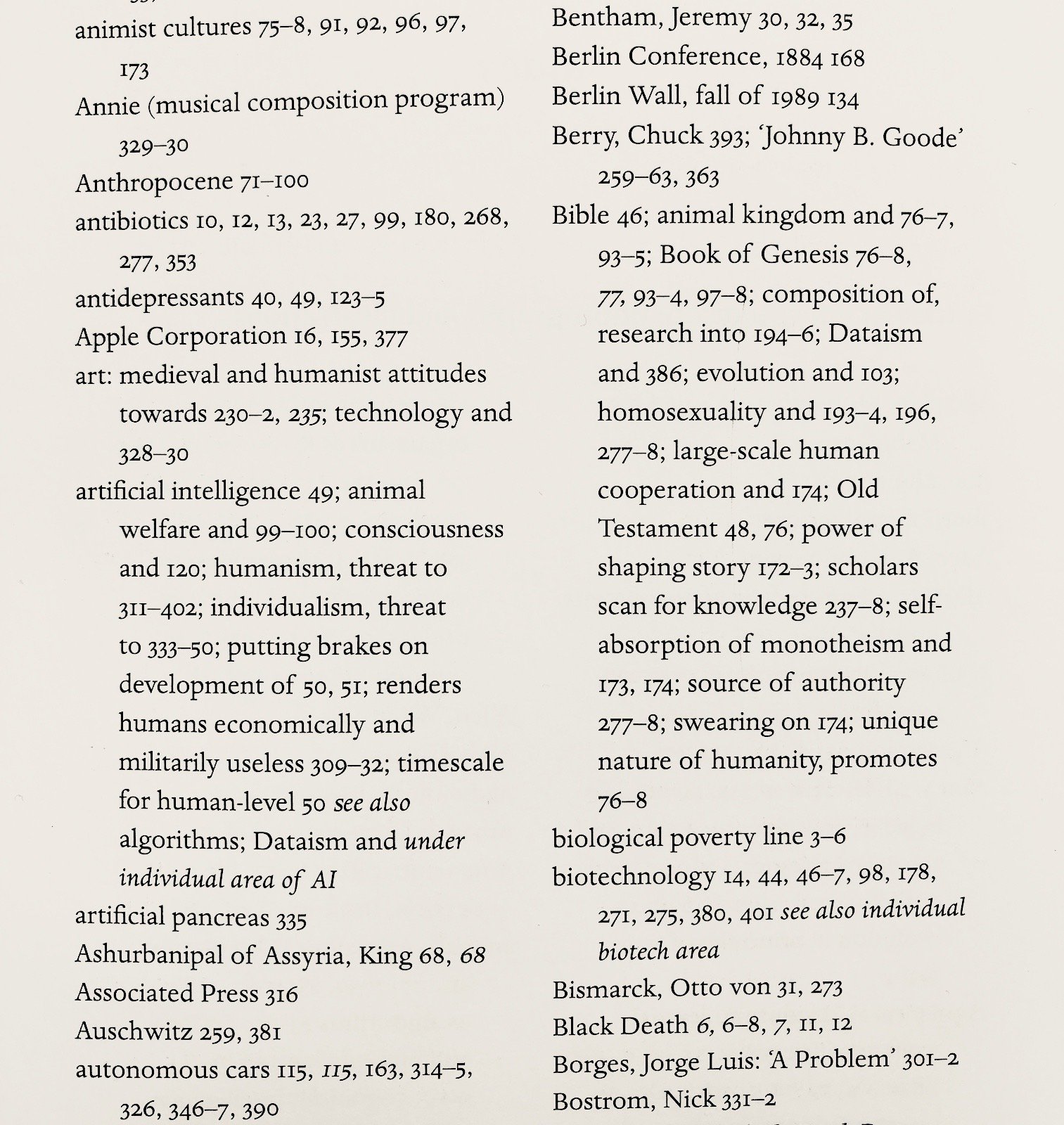 |
I can see that the author is going to spend more time on “AI” and the “Bible” than “animist cultures” or “Chuck Berry.” That’s too bad, I kind of feel like a book about animist cultures and Chuck Berry would be pretty interesting.
Anyway, there’s something called the “biological poverty line” which I’ve never heard of before....interesting. It’s early in the book (pages 3-6), and seems to be followed by the “Black Death,” which means the book is going to start with disease and poverty—how comforting.
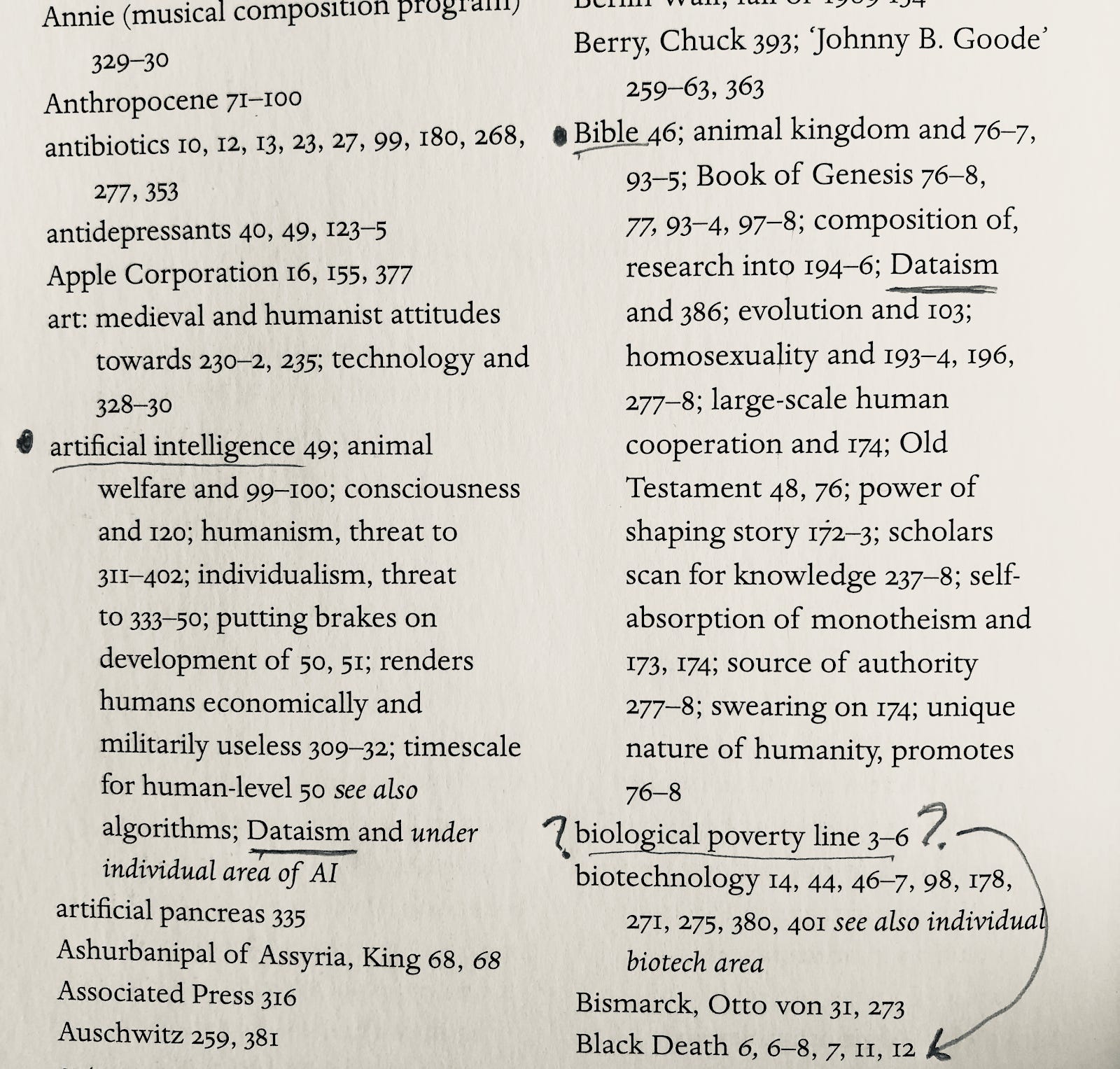 |
Let’s look a bit deeper at one of these topics. Say, the Bible.
Under “Bible,” we get some interesting subtopics:
Parts of the Bible
Book of Genesis
Old Testament
Not Parts of the Bible
Composition of research
Dataism
Evolution
Homosexuality
Large-scale human cooperation
Power of shaping story
Scholars scan for knowledge
Absorption of monotheism
Source of authority
Swearing on
Unique nature of humanity
With “Source of Authority,” “Large-Scale Human Cooperation,” and “Power of shaping story,” it seems like the author is going to explore the Bible’s effect on maintaining social order. Also, this book seems to be less of a historical deep dive since Dataism obviously isn't a term that comes from the Bible.
In fact, Dataism isn’t a word I’ve ever seen before. I bet you there’s a good chance that’s the author’s own concept. When I do a quick scan of the index I find that—yes indeed—it is the author’s concept, and it seems to be a cumulative concept, as it’s coming at the end of the book on page 386.
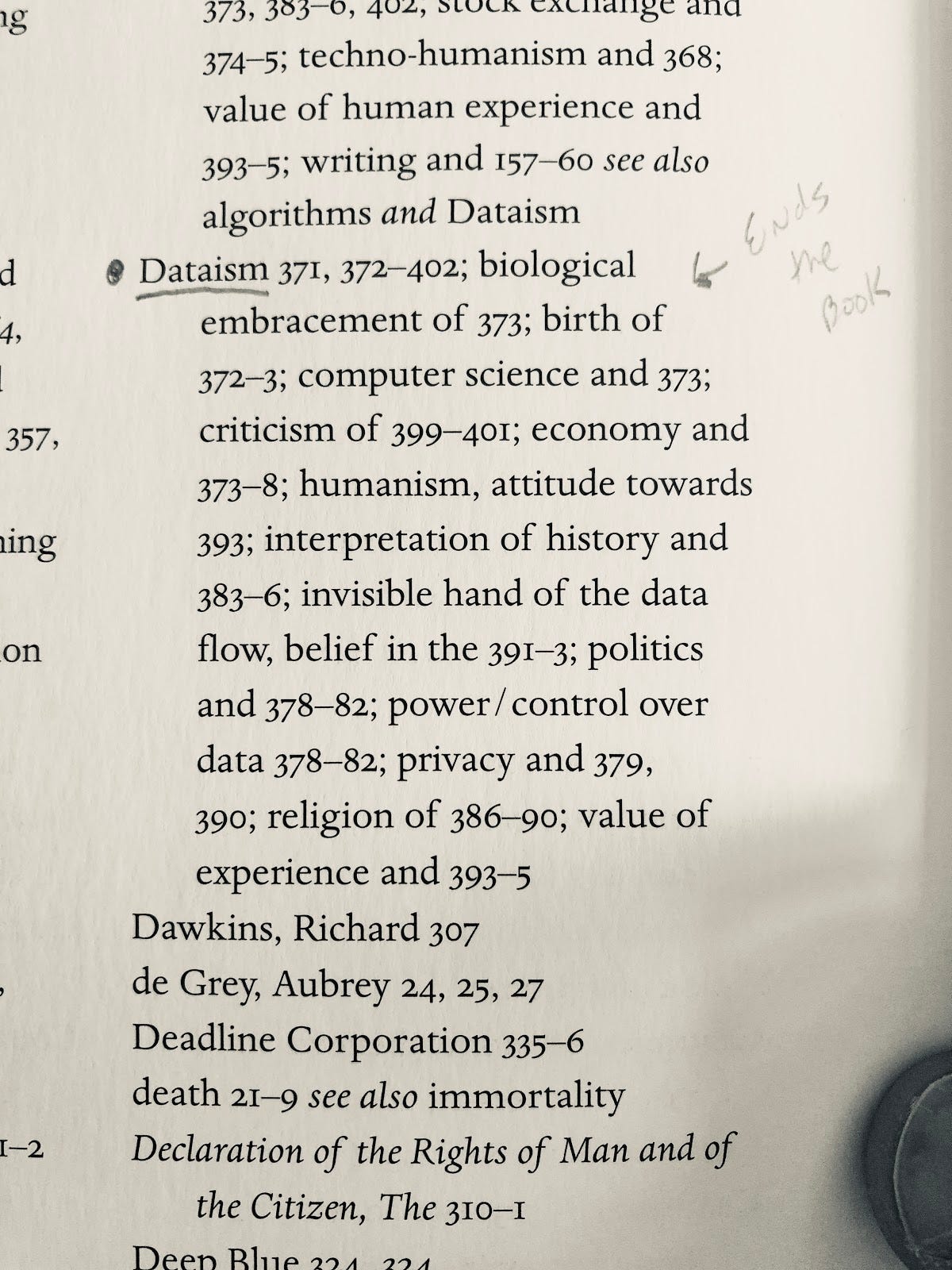 |
Any time something in the index interests me, I’ll write it down. I do this on a physical notecard or in a document. So, by the end of reading the index I’ll have all of the most interesting and relevant pieces of information in one place.
It usually looks something like this:
Algorithms, AI (individualism threat to 333-50), Data-processing (156-370), Dataism (371 to end), economics (202-390), evolution (37-397), Google(24,28,115), Techno-humanism, Transcranial Stimulators (45, 289-92, 367-8)
Animals, Brain, Consciousness (100’s then back in 300’s), intelligence, Self,
Catholic Church (tech innovations (276), Bible (cooperation 174-78), Christianity, Communism, God (heavy), Gods (heavy), humanism, Liberal humanism (schism 248-59), (other religions too: Buddhism, Judaism, Islam),
China, United States…
I typically list page numbers when I plan on jumping to that topic. Also, page number ranges can give me a sense of how the book is laid out. But often I just lazily look at the topic names and write down what sticks out to me, including subtopics.
What is this book trying to get across?
For Homo Deus, it looks like this author is trying to set up a new paradigm called Dataism. It might be related to scaling human cooperation, and he seems to be supporting his thesis with some tenets from techno-humanism, pre-existing religions, and probably some AI for extra spice.
Am I interested?
Eh, kinda. Enough to delve deeper for sure.
The TOC is the Skeleton of a Book
Once I’m armed with a handy-dandy list of topics culled from the index, I compare my index map with the good old TOC (table of contents). The TOC is the skeleton of the book, and the terms from the indexes you grabbed earlier are like the fleshed-out limbs.
The TOC shows the way the author wants you to understand the progression of the book. (Like the title, authors also think about what the TOC looks like.) It gives you the big picture of the approach. Then the index helps you fill in the types and level of details.
You could start your process at the TOC if you want to, but I have found that starting with the index and overlaying that research on top of TOC is most helpful.
At this point, I like to take the topic card and set it next to the table of contents to see if I can get a sense of the author’s point(s).
Let’s check out the table of contents in this book:
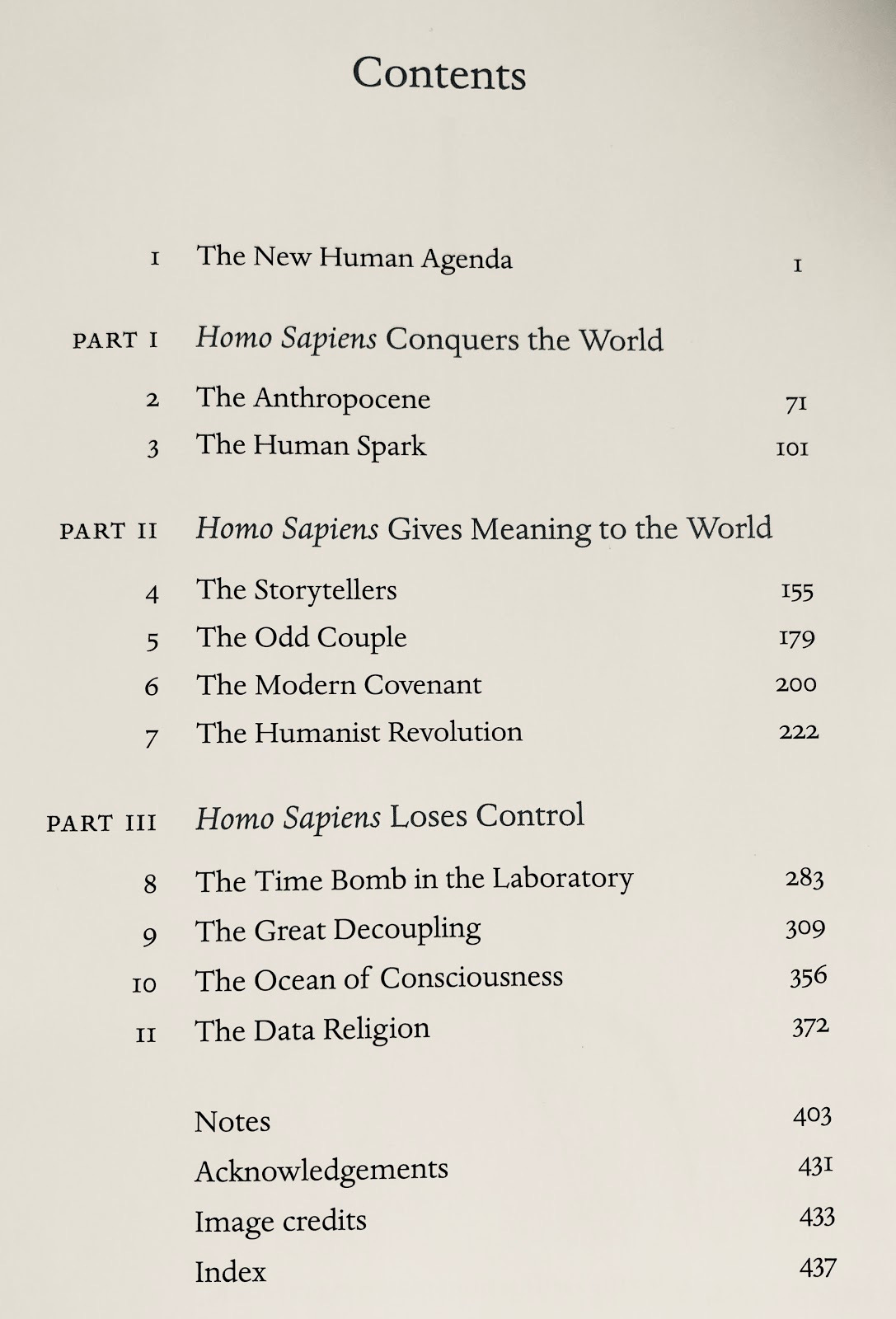 |
It looks like Harari takes a historical view of humanity as he leads us to what is coming next—if I can assume as much, because it’s the final chapter of his book: “The Data Religion.” And when I look at the index and account for the way page numbers and chapters align, I can see the stuff about “Dataism” is overlaid against a chapter titled “The Data Religion.”
My best guess right now is that this book is about how we will organize ourselves using data in the future instead of religion.
Do this for a few minutes. Build a rough map in your mind of the book. It’s sort of like connecting the dots between the chapter titles in the TOC and the topics and page numbers listed in the index. All of the above takes 5-15 minutes and is really a simplified version of “inspectional reading,” popularized by Adler and van Doren, which is just a more methodological skimming or “pre-reading” process.
Once we’ve answered the question of what the book is about, the remaining question—and indeed the main question—remains.
Do you care?
If not, throw the notecard in the front pages somewhere (for future reference) and toss the book back on the shelf. Maybe, if you are interested in knowing more, spend an hour or two reading some of the sections that interest you. For instance, with Homo Deus, I’m likely to read a few index points and the final chapter on Dataism.
But, before I do any of that, I always skim the preface.
Preview with the Preface
After I’ve contemplated the title, mapped out the book with the index and the table of contents, I typically skim the preface to see how the map that I created in my mind matches what the author is telling me as they introduce the book. It’s a feedback loop on my own deductive ability. Sometimes I’m way off, and I recognize that I was overlaying my own assumptions on the author.
For instance, with Dataism and the Bible, I don’t know which of these the author thinks is superior. This could be a book about evolving towards Dataism, or it could be more of a fall from grace story. Or it could be something altogether different. The preface usually clears this up.
In the preface, good authors will tell you right away what the book is about and where it is going. In that way, the preface is like the trailer to a movie. Maybe you see Ben Affleck and Pee Wee Herman are co-starring and lose interest. Maybe the author makes a point you never thought of, and you become more interested. Follow that instinct.
I’ll get through a preface in about 5 minutes. Skimming is my friend—I don’t need to memorize or meditate too deeply on it. It’s mostly just to make sure my mental map is on the money.
The preface and the index are indispensable to understanding what the book is about. So far, all we are trying to understand is: what is this book trying to get across?
But now we have to come back to the key question.
Do I care?
There are a lot of books out there, and I don’t have the time to get through them all. So when I’m investing time in reading, I want to keep curiosity in the driver's seat and not let it slip out the back door (and no, my home is not on wheels). Forcing myself to trudge through a boring book can put my reading habit at risk, as I imagine it does for a lot of people.
What’s nice about the above process is that it can take 15 minutes or an hour—however much time I want to invest in it—but I no longer have the mental baggage of lugging around a huge list of books that I’m “going to read one day.” I can just buy books as people recommend, and follow the above process to see how interested I am.
However, I typically pick up a book because I need to solve a problem, or I’m already interested in the topic. So, since there will be some useful knowledge nuggets within the chapters that I need, my goal now is to pull them out.
How to Extract the Knowledge Nuggets
So how do I get those useful knowledge nuggets? I use the index map (page numbers) and again, I follow my interests or problem-solving needs. I start by reading the pages corresponding to the seemingly useful parts from the index. Yeah, right in the middle of the book. Feel free to just start reading on page 212. Seriously.
For instance, from the index map above, do I really want to understand what the “biological poverty line” is? Or did some other topic seem more interesting? This is where I break free of the author's structure, and delve into the book to find the pieces I need or that I want to know.
I suggest following a topic over multiple chapters, so if the author starts talking about something on page 2, picks it up again on pages 25-29, and then again at 101-105, read those pages in sequence. Other interesting topics might be mentioned along the way. If so, add those to your map and find their places in the index. Let curiosity and interest take the lead.
Interact with the Book
Writing in the margins and taking notes is also a huge part of this process for me; underlining words and marking up pages in whatever way sparks a bit of that Marie Kondo Joy that’s going around. I like to draft points to myself—notes, ideas, thoughts. If it’s a hard copy of a book I’ll use a pencil. If it’s digital, I’ll use the built-in notes app.
One thing I appreciate about notations in a book is that it allows you to track your thinking about the book over time. If you do end up coming back later, these little notes can serve the same purpose that commenting your code does.
Take a look at a page from one of the books I’ve read:
 |
Go Until You Know How Interested You Are
I continue to loop through pieces of the book from the index until I either lose interest or feel like I’ve gotten all that I need for now.
If I’m not interested enough to read it from cover to cover, I’ll export the “knowledge nuggets” that I did find useful, throw the note card into the book, and put it on the shelf until interest or necessity brings me back. Having a system like this helps me know which books to bring back, and having this notecard map as a bookmark helps me find my way through the book again.
Also, I will put any truly useful information from the book into Readwise to reference/search later, Anki if I want to remember it, or a playbook / to-do list to act upon.
This is how I break down a book to see how interested I am, and to help me locate the valuable pieces of the book to me. Often this is the end for most books. However, if I want to go a bit deeper I can either read it front to back or in combination with other related books.
A Quick Note on Reading a Book From Front to Back
If the book is really interesting I will just follow that interest to the exclusion of everything else. If you have a book you can’t put down, then it makes reading overall easier and more enjoyable.
The biggest return on time I’ve found is to review key points from the previous chapters before starting a new chapter. I’ve found that Anki is well suited for this, but you can use notes to yourself as well.
The basic process is read, review, read, review. I do this to prime my memory with what I’ve learned in the past (maybe even just the day before) and I’ve found that it really helps me “knit” the book together in my mind.
Here’s an example of what a chapter-by-chapter breakdown of the book Numsense looks like in my Anki system:
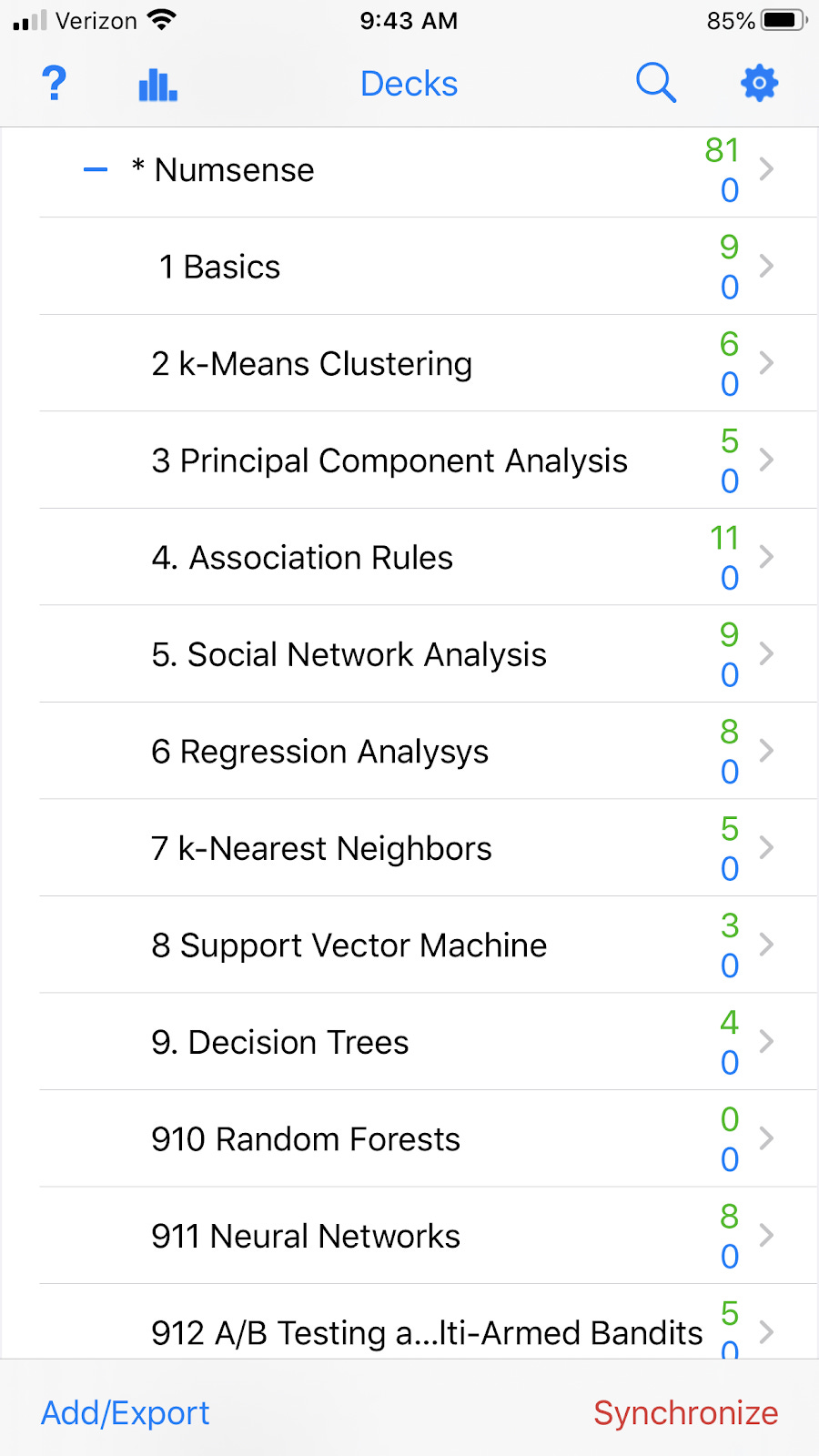 |
One side benefit of a system like this is that it allows me to do a targeted review and get back up to speed on a book’s ideas very quickly. Also, if I’m reading multiple books at once, this process allows me to start knitting key ideas across books together in my mind. And on that topic…
A Quick Note on Reading More Than One Book at a Time
Alright, let’s say I wanted to learn more about a topic or get a sense of a whole field of study really quickly—say “management” or “the future.” Well, I could serially read one book at a time, but that will take a while. I could speed read, but that’s just a faster type of serial reading.
Instead, I combine each technique above, reading some of the books in the field front to back, and others more surgically, and putting it all into Readwise to reference/search, Anki to make sure I know it, and my to-do list to act upon. This allows me to simultaneously build out a large reference catalog in Readwise and mentally knit together all the ideas using Anki.
To start reading multiple books, I recommend using this technique across all of them, letting the indexes guide you. Feel free to stay in one for a while if you want to. Write notes, highlight words, or draw tiny cats everywhere...I mean the options are pretty limitless here.
I typically fall into reading one or two of the books from front to back, while surgically removing knowledge nuggets from the other books, in order to build out a broader picture of the topic.
I use the natural gravitation toward that one book I’m interested in to catapult me into the topic, and once I’ve tired of that book for the day, I’m mentally primed to continue delving into the topic with other books in the pile. Even if I’m just surgically pulling interesting pieces from the index.
But, this is all another post for another day.
Regardless of how I’m reading—whether I’m reading one book from front to back, or reading multiple books across a topic— this process has changed my relationship to my library. It’s gone from something that I use to store books to something that I continually interact with and use in my day to day life to solve problems or push my thinking forward.
I hope it does for you as well! :-)
This piece was edited by Paul Smalera.

